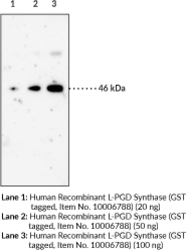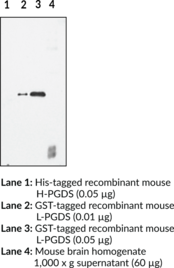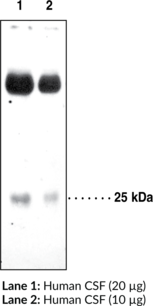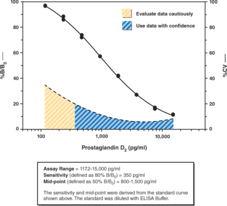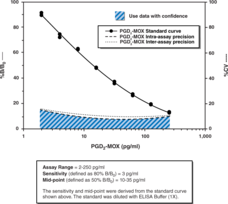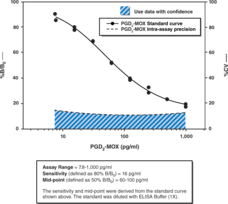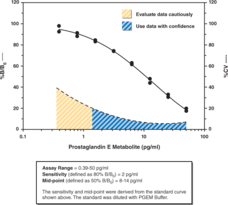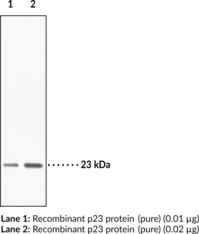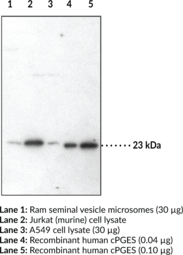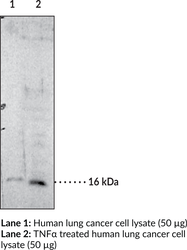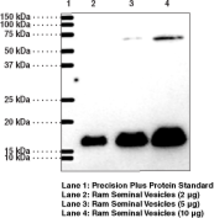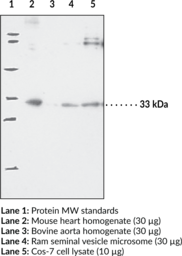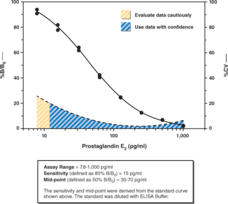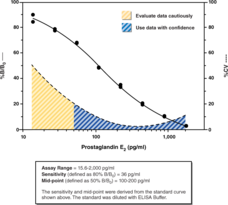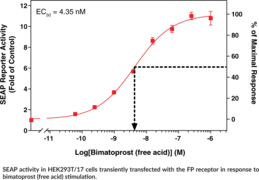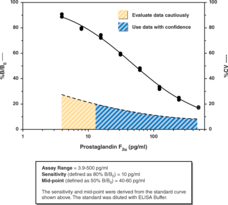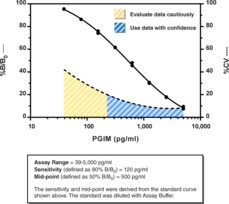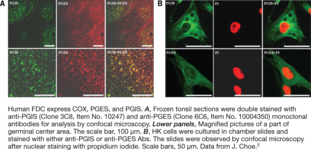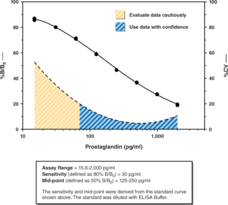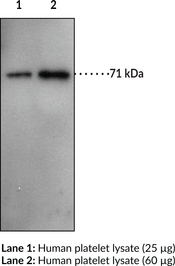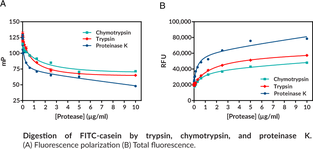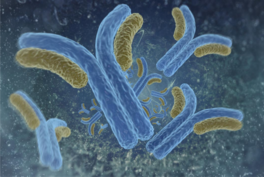ELISA Kits
Showing 2851–3000 of 3623 results
-
Prostaglandin D synthase (PGDS) catalyzes the isomerization of PGH2 to produce PGD2. PGD2 induces sleep, regulates nociception, inhibits platelet aggregation, and acts as an allergic mediator. Two distinct types of PGDS have been identified, namely the lipocalin type enzyme (β-trace) and the hematopoietic enzyme.{8448,4387} Lipocalin-type PGDS is localized in the central nervous system, genital organs of various mammals and the human heart.{8448,5971,4388,8451} Patients with chronic renal failure and hypertension exhibit elevated amounts of lipocalin-type PGDS in serum and urine.{10440} The lipocalin-type PGDS has been identified as β-trace (~24 kDa), which is a major protein in the human cerebrospinal fluid.{4387,1543}
Brand:CaymanSKU:10004342 - 1 eaAvailable on backorder
Prostaglandin D synthase (PGDS) catalyzes the isomerization of PGH2 to produce PGD2. PGD2 induces sleep, regulates nociception, inhibits platelet aggregation, and acts as an allergic mediator. Two distinct types of PGDS have been identified, namely the lipocalin type enzyme (β-trace) and the hematopoietic enzyme.{8848,4387} Lipocalin-type PGDS (L-PGDS) is localized in the central nervous system, genital organs of various mammals and the human heart.{8848,5971,4388,8451} Patients with chronic renal failure and hypertension exhibit elevated amounts of L-PGDS in serum and urine.{10440} The L-PGD synthase has been identified as β-trace, which is a major protein in the human cerebrospinal fluid.{4387,1543}
Brand:CaymanSKU:10004344 - 500 µlAvailable on backorder
Prostaglandin D synthase (PGDS) catalyzes the isomerization of PGH2 to produce PGD2. PGD2 induces sleep, regulates nociception, inhibits platelet aggregation, and acts as an allergic mediator. Two distinct types of PGDS have been identified, namely the lipocalin-type enzyme (β-trace) and the hematopoietic enzyme.{8448,4387} Lipocalin-type PGDS is localized in the central nervous system and male genital organs of various mammals and the human heart whereas the hematopoietic PGDS is widely distributed in the peripheral tissues and localized in the antigen-presenting cells, mast cells, and megakaryocytes.{8448,5971,4388,8451} The lipocalin-type PGDS has been identified as β-trace, which is a major protein in human cerebrospinal fluid.{4387,1543} Human lipocalin-type PGD synthase is a 190 amino acid protein with a calculated molecular weight of 21,016.{8449}
Brand:CaymanSKU:160003 - 1 eaAvailable on backorder
Prostaglandin D2 (PGD2) is biosynthesized in the brain by a soluble, 26 kDa glutathione-independent lipocalin-type PGD2 synthase. This PGD2 accumulates in the cerebrospinal fluid (CSF), where it induces physiologic sleep in rats and humans. PGD2 is also synthesized in mast cells and leukocytes by a cellular, myeloid-type, glutathione-dependent PGD synthase. This PGD2 which is formed in the intracellular and vascular compartments is rapidly metabolized to 11β-PGF2α and other metabolites. Measurement of the parent eicosanoid PGD2 is appropriate in cell culture lysates and in CSF, where concentrations of several hundred pg/ml have been measured. Cayman’s PGD2 ELISA Kit is a competitive assay that can be used for quantification of PGD2 in cell culture lysates and enzymatic reactions.
Brand:CaymanSKU:512031 - 480 solid wellsAvailable on backorder
Prostaglandin D2 (PGD2) is biosynthesized in the brain by a soluble, 26 kDa glutathione-independent lipocalin-type PGD2 synthase. This PGD2 accumulates in the cerebrospinal fluid (CSF), where it induces physiologic sleep in rats and humans. PGD2 is also synthesized in mast cells and leukocytes by a cellular, myeloid-type, glutathione-dependent PGD synthase. This PGD2 which is formed in the intracellular and vascular compartments is rapidly metabolized to 11β-PGF2α and other metabolites. Measurement of the parent eicosanoid PGD2 is appropriate in cell culture lysates and in CSF, where concentrations of several hundred pg/ml have been measured. Cayman’s PGD2 ELISA Kit is a competitive assay that can be used for quantification of PGD2 in cell culture lysates and enzymatic reactions.
Brand:CaymanSKU:512031 - 480 strip wellsAvailable on backorder
Prostaglandin D2 (PGD2) is biosynthesized in the brain by a soluble, 26 kDa glutathione-independent lipocalin-type PGD2 synthase. This PGD2 accumulates in the cerebrospinal fluid (CSF), where it induces physiologic sleep in rats and humans. PGD2 is also synthesized in mast cells and leukocytes by a cellular, myeloid-type, glutathione-dependent PGD synthase. This PGD2 which is formed in the intracellular and vascular compartments is rapidly metabolized to 11β-PGF2α and other metabolites. Measurement of the parent eicosanoid PGD2 is appropriate in cell culture lysates and in CSF, where concentrations of several hundred pg/ml have been measured. Cayman’s PGD2 ELISA Kit is a competitive assay that can be used for quantification of PGD2 in cell culture lysates and enzymatic reactions.
Brand:CaymanSKU:512031 - 96 solid wellsAvailable on backorder
Prostaglandin D2 (PGD2) is biosynthesized in the brain by a soluble, 26 kDa glutathione-independent lipocalin-type PGD2 synthase. This PGD2 accumulates in the cerebrospinal fluid (CSF), where it induces physiologic sleep in rats and humans. PGD2 is also synthesized in mast cells and leukocytes by a cellular, myeloid-type, glutathione-dependent PGD synthase. This PGD2 which is formed in the intracellular and vascular compartments is rapidly metabolized to 11β-PGF2α and other metabolites. Measurement of the parent eicosanoid PGD2 is appropriate in cell culture lysates and in CSF, where concentrations of several hundred pg/ml have been measured. Cayman’s PGD2 ELISA Kit is a competitive assay that can be used for quantification of PGD2 in cell culture lysates and enzymatic reactions.
Brand:CaymanSKU:512031 - 96 strip wellsAvailable on backorder
Brand:CaymanSKU:412034 - 1 eaAvailable on backorder
Brand:CaymanSKU:412014 - 1 eaAvailable on backorder
Prostaglandin D2 (PGD2) is biosynthesized in the brain by a soluble, 26 kDa glutathione-independent lipocalin-type PGD2 synthase. This PGD2 accumulates in the cerebrospinal fluid (CSF), where it induces physiologic sleep in rats and humans. PGD2 is also synthesized in mast cells and leukocytes by a cellular, myeloid-type, glutathione-dependent PGD synthase. This PGD2 which is formed in the intracellular and vascular compartments is rapidly metabolized to 11β-PGF2α and other metabolites. Measurement of the parent eicosanoid PGD2 is appropriate in cell culture lysates and in CSF, where concentrations of several hundred pg/ml have been measured. Cayman’s PGD2 Express ELISA Kit is a competitive assay that can be used for quantification of PGD2 in cell culture lysates and enzymatic reactions. This ELISA offers the convenience of a fast assay with a two hour incubation time and one hour development time, while still achieving an assay range of approximately 117.2-15,000 pg/ml and a sensitvity (80% B/B0) of approximately 350 pg/ml.
Brand:CaymanSKU:512041 - 480 solid wellsAvailable on backorder
Prostaglandin D2 (PGD2) is biosynthesized in the brain by a soluble, 26 kDa glutathione-independent lipocalin-type PGD2 synthase. This PGD2 accumulates in the cerebrospinal fluid (CSF), where it induces physiologic sleep in rats and humans. PGD2 is also synthesized in mast cells and leukocytes by a cellular, myeloid-type, glutathione-dependent PGD synthase. This PGD2 which is formed in the intracellular and vascular compartments is rapidly metabolized to 11β-PGF2α and other metabolites. Measurement of the parent eicosanoid PGD2 is appropriate in cell culture lysates and in CSF, where concentrations of several hundred pg/ml have been measured. Cayman’s PGD2 Express ELISA Kit is a competitive assay that can be used for quantification of PGD2 in cell culture lysates and enzymatic reactions. This ELISA offers the convenience of a fast assay with a two hour incubation time and one hour development time, while still achieving an assay range of approximately 117.2-15,000 pg/ml and a sensitvity (80% B/B0) of approximately 350 pg/ml.
Brand:CaymanSKU:512041 - 480 strip wellsAvailable on backorder
Prostaglandin D2 (PGD2) is biosynthesized in the brain by a soluble, 26 kDa glutathione-independent lipocalin-type PGD2 synthase. This PGD2 accumulates in the cerebrospinal fluid (CSF), where it induces physiologic sleep in rats and humans. PGD2 is also synthesized in mast cells and leukocytes by a cellular, myeloid-type, glutathione-dependent PGD synthase. This PGD2 which is formed in the intracellular and vascular compartments is rapidly metabolized to 11β-PGF2α and other metabolites. Measurement of the parent eicosanoid PGD2 is appropriate in cell culture lysates and in CSF, where concentrations of several hundred pg/ml have been measured. Cayman’s PGD2 Express ELISA Kit is a competitive assay that can be used for quantification of PGD2 in cell culture lysates and enzymatic reactions. This ELISA offers the convenience of a fast assay with a two hour incubation time and one hour development time, while still achieving an assay range of approximately 117.2-15,000 pg/ml and a sensitvity (80% B/B0) of approximately 350 pg/ml.
Brand:CaymanSKU:512041 - 96 solid wellsAvailable on backorder
Prostaglandin D2 (PGD2) is biosynthesized in the brain by a soluble, 26 kDa glutathione-independent lipocalin-type PGD2 synthase. This PGD2 accumulates in the cerebrospinal fluid (CSF), where it induces physiologic sleep in rats and humans. PGD2 is also synthesized in mast cells and leukocytes by a cellular, myeloid-type, glutathione-dependent PGD synthase. This PGD2 which is formed in the intracellular and vascular compartments is rapidly metabolized to 11β-PGF2α and other metabolites. Measurement of the parent eicosanoid PGD2 is appropriate in cell culture lysates and in CSF, where concentrations of several hundred pg/ml have been measured. Cayman’s PGD2 Express ELISA Kit is a competitive assay that can be used for quantification of PGD2 in cell culture lysates and enzymatic reactions. This ELISA offers the convenience of a fast assay with a two hour incubation time and one hour development time, while still achieving an assay range of approximately 117.2-15,000 pg/ml and a sensitvity (80% B/B0) of approximately 350 pg/ml.
Brand:CaymanSKU:512041 - 96 strip wellsAvailable on backorder
Brand:CaymanSKU:412044 - 1 eaAvailable on backorder
Brand:CaymanSKU:412012 - 100 dtnAvailable on backorder
Brand:CaymanSKU:412012 - 500 dtnAvailable on backorder
Prostaglandin D2 (PGD2) is biosynthesized in the brain by a soluble, 26 kD glutathione-independent lipocalin-type PGD2 synthase.{1665} PGD2 accumulates in the cerebrospinal fluid (CSF), where it induces physiologic sleep in rats and humans.{1331} PGD2 is also synthesized by mast cells and leukocytes by a cellular, myeloid-type, glutathione-dependent PGD synthase. This PGD2 which is formed in the intracellular and vascular compartments is rapidly metabolized to 11β-PGF2α.{416} Thus, urinary measurements of PGD synthesis are most appropriately focused on the measurement of 11β-PGF2α. Measurement of the parent eicosanoid PGD2 is appropriate in the supernatants of cell cultures, where PGD2 levels may reach several ng/ml, and in CSF, where concentrations of several hundred pg/ml have been measured.{6647} All studies of PGD2 biosynthesis should take into consideration the chemical instability of PGD2 and its rapid degradation in the presence of serum proteins such as albumin.{1742} PGD2 also readily degrades in both acidic and basic media to give a variety of decomposition products. Similarly, antigenic protein conjugates of PGD2, synthesized for the production of antisera, show considerable amounts of decomposition. Thus, the resulting antibody response is heterogeneous with poor specificity. This makes PGD2 assay systems based on the parent compound unreliable and difficult to interpret. This PGD2-MOX ELISA is based on the conversion of PGD2 to a stable MOX derivative. Treatment of the sample with methoxylamine hydrochloride (MOX HCl) converts PGD2 into PGD2-MOX, preventing its further chemical degradation. The antiserum used in the assay was developed using conjugates of this derivative and is very specific for PGD2-MOX. The assay has been validated against stable isotope dilution GC/MS. Measurements using both techniques on identical samples showed a correlation coefficient of 0.97.
Brand:CaymanSKU:512011 - 480 solid wellsAvailable on backorder
Prostaglandin D2 (PGD2) is biosynthesized in the brain by a soluble, 26 kD glutathione-independent lipocalin-type PGD2 synthase.{1665} PGD2 accumulates in the cerebrospinal fluid (CSF), where it induces physiologic sleep in rats and humans.{1331} PGD2 is also synthesized by mast cells and leukocytes by a cellular, myeloid-type, glutathione-dependent PGD synthase. This PGD2 which is formed in the intracellular and vascular compartments is rapidly metabolized to 11β-PGF2α.{416} Thus, urinary measurements of PGD synthesis are most appropriately focused on the measurement of 11β-PGF2α. Measurement of the parent eicosanoid PGD2 is appropriate in the supernatants of cell cultures, where PGD2 levels may reach several ng/ml, and in CSF, where concentrations of several hundred pg/ml have been measured.{6647} All studies of PGD2 biosynthesis should take into consideration the chemical instability of PGD2 and its rapid degradation in the presence of serum proteins such as albumin.{1742} PGD2 also readily degrades in both acidic and basic media to give a variety of decomposition products. Similarly, antigenic protein conjugates of PGD2, synthesized for the production of antisera, show considerable amounts of decomposition. Thus, the resulting antibody response is heterogeneous with poor specificity. This makes PGD2 assay systems based on the parent compound unreliable and difficult to interpret. This PGD2-MOX ELISA is based on the conversion of PGD2 to a stable MOX derivative. Treatment of the sample with methoxylamine hydrochloride (MOX HCl) converts PGD2 into PGD2-MOX, preventing its further chemical degradation. The antiserum used in the assay was developed using conjugates of this derivative and is very specific for PGD2-MOX. The assay has been validated against stable isotope dilution GC/MS. Measurements using both techniques on identical samples showed a correlation coefficient of 0.97.
Brand:CaymanSKU:512011 - 480 strip wellsAvailable on backorder
Prostaglandin D2 (PGD2) is biosynthesized in the brain by a soluble, 26 kD glutathione-independent lipocalin-type PGD2 synthase.{1665} PGD2 accumulates in the cerebrospinal fluid (CSF), where it induces physiologic sleep in rats and humans.{1331} PGD2 is also synthesized by mast cells and leukocytes by a cellular, myeloid-type, glutathione-dependent PGD synthase. This PGD2 which is formed in the intracellular and vascular compartments is rapidly metabolized to 11β-PGF2α.{416} Thus, urinary measurements of PGD synthesis are most appropriately focused on the measurement of 11β-PGF2α. Measurement of the parent eicosanoid PGD2 is appropriate in the supernatants of cell cultures, where PGD2 levels may reach several ng/ml, and in CSF, where concentrations of several hundred pg/ml have been measured.{6647} All studies of PGD2 biosynthesis should take into consideration the chemical instability of PGD2 and its rapid degradation in the presence of serum proteins such as albumin.{1742} PGD2 also readily degrades in both acidic and basic media to give a variety of decomposition products. Similarly, antigenic protein conjugates of PGD2, synthesized for the production of antisera, show considerable amounts of decomposition. Thus, the resulting antibody response is heterogeneous with poor specificity. This makes PGD2 assay systems based on the parent compound unreliable and difficult to interpret. This PGD2-MOX ELISA is based on the conversion of PGD2 to a stable MOX derivative. Treatment of the sample with methoxylamine hydrochloride (MOX HCl) converts PGD2 into PGD2-MOX, preventing its further chemical degradation. The antiserum used in the assay was developed using conjugates of this derivative and is very specific for PGD2-MOX. The assay has been validated against stable isotope dilution GC/MS. Measurements using both techniques on identical samples showed a correlation coefficient of 0.97.
Brand:CaymanSKU:512011 - 96 solid wellsAvailable on backorder
Prostaglandin D2 (PGD2) is biosynthesized in the brain by a soluble, 26 kD glutathione-independent lipocalin-type PGD2 synthase.{1665} PGD2 accumulates in the cerebrospinal fluid (CSF), where it induces physiologic sleep in rats and humans.{1331} PGD2 is also synthesized by mast cells and leukocytes by a cellular, myeloid-type, glutathione-dependent PGD synthase. This PGD2 which is formed in the intracellular and vascular compartments is rapidly metabolized to 11β-PGF2α.{416} Thus, urinary measurements of PGD synthesis are most appropriately focused on the measurement of 11β-PGF2α. Measurement of the parent eicosanoid PGD2 is appropriate in the supernatants of cell cultures, where PGD2 levels may reach several ng/ml, and in CSF, where concentrations of several hundred pg/ml have been measured.{6647} All studies of PGD2 biosynthesis should take into consideration the chemical instability of PGD2 and its rapid degradation in the presence of serum proteins such as albumin.{1742} PGD2 also readily degrades in both acidic and basic media to give a variety of decomposition products. Similarly, antigenic protein conjugates of PGD2, synthesized for the production of antisera, show considerable amounts of decomposition. Thus, the resulting antibody response is heterogeneous with poor specificity. This makes PGD2 assay systems based on the parent compound unreliable and difficult to interpret. This PGD2-MOX ELISA is based on the conversion of PGD2 to a stable MOX derivative. Treatment of the sample with methoxylamine hydrochloride (MOX HCl) converts PGD2 into PGD2-MOX, preventing its further chemical degradation. The antiserum used in the assay was developed using conjugates of this derivative and is very specific for PGD2-MOX. The assay has been validated against stable isotope dilution GC/MS. Measurements using both techniques on identical samples showed a correlation coefficient of 0.97.
Brand:CaymanSKU:512011 - 96 strip wellsAvailable on backorder
Brand:CaymanSKU:400152 - 100 dtnAvailable on backorder
Brand:CaymanSKU:400152 - 500 dtnAvailable on backorder
Prostaglandin D2 (PGD2) is biosynthesized in the brain by a lipocalin-type PGD2 synthase where it acts in the CNS to promote sleep induction and lowering of body temperature.{328} PGD2 is also the major eicosanoid product of mast cells and is synthesized in large quantities by a hematopoetic-type PGD synthase during allergic and asthmatic anaphylaxis.{8034,7666} Measurement of the parent eicosanoid PGD2 is appropriate in the supernatants of cell cultures, where PGD2 levels may reach several ng/ml, and in CSF, where concentrations of several hundred pg/ml have been measured.{4690} Cayman Chemical’s PGD2-MOX Express ELISA is a competitive assay that permits the rapid measurement of PGD2 from biological samples, requiring only 1 hour incubation and development times for each step. The methodology for the assay is the same as that employed in Cayman’s widely utilized PGD2-MOX ELISA (Item No. 512011). While Item No. 512011 offers superior sensitivity (80% B/B0 ~3.1 pg/ml), the new PGD2-MOX Express EIA offers the convenience of a fast assay while still achieving an 80% B/B0 ~16 pg/ml and an assay range of 7.8-1,000 pg/ml.
Brand:CaymanSKU:500151 - 480 solid wellsAvailable on backorder
Prostaglandin D2 (PGD2) is biosynthesized in the brain by a lipocalin-type PGD2 synthase where it acts in the CNS to promote sleep induction and lowering of body temperature.{328} PGD2 is also the major eicosanoid product of mast cells and is synthesized in large quantities by a hematopoetic-type PGD synthase during allergic and asthmatic anaphylaxis.{8034,7666} Measurement of the parent eicosanoid PGD2 is appropriate in the supernatants of cell cultures, where PGD2 levels may reach several ng/ml, and in CSF, where concentrations of several hundred pg/ml have been measured.{4690} Cayman Chemical’s PGD2-MOX Express ELISA is a competitive assay that permits the rapid measurement of PGD2 from biological samples, requiring only 1 hour incubation and development times for each step. The methodology for the assay is the same as that employed in Cayman’s widely utilized PGD2-MOX ELISA (Item No. 512011). While Item No. 512011 offers superior sensitivity (80% B/B0 ~3.1 pg/ml), the new PGD2-MOX Express EIA offers the convenience of a fast assay while still achieving an 80% B/B0 ~16 pg/ml and an assay range of 7.8-1,000 pg/ml.
Brand:CaymanSKU:500151 - 480 strip wellsAvailable on backorder
Prostaglandin D2 (PGD2) is biosynthesized in the brain by a lipocalin-type PGD2 synthase where it acts in the CNS to promote sleep induction and lowering of body temperature.{328} PGD2 is also the major eicosanoid product of mast cells and is synthesized in large quantities by a hematopoetic-type PGD synthase during allergic and asthmatic anaphylaxis.{8034,7666} Measurement of the parent eicosanoid PGD2 is appropriate in the supernatants of cell cultures, where PGD2 levels may reach several ng/ml, and in CSF, where concentrations of several hundred pg/ml have been measured.{4690} Cayman Chemical’s PGD2-MOX Express ELISA is a competitive assay that permits the rapid measurement of PGD2 from biological samples, requiring only 1 hour incubation and development times for each step. The methodology for the assay is the same as that employed in Cayman’s widely utilized PGD2-MOX ELISA (Item No. 512011). While Item No. 512011 offers superior sensitivity (80% B/B0 ~3.1 pg/ml), the new PGD2-MOX Express EIA offers the convenience of a fast assay while still achieving an 80% B/B0 ~16 pg/ml and an assay range of 7.8-1,000 pg/ml.
Brand:CaymanSKU:500151 - 96 solid wellsAvailable on backorder
Prostaglandin D2 (PGD2) is biosynthesized in the brain by a lipocalin-type PGD2 synthase where it acts in the CNS to promote sleep induction and lowering of body temperature.{328} PGD2 is also the major eicosanoid product of mast cells and is synthesized in large quantities by a hematopoetic-type PGD synthase during allergic and asthmatic anaphylaxis.{8034,7666} Measurement of the parent eicosanoid PGD2 is appropriate in the supernatants of cell cultures, where PGD2 levels may reach several ng/ml, and in CSF, where concentrations of several hundred pg/ml have been measured.{4690} Cayman Chemical’s PGD2-MOX Express ELISA is a competitive assay that permits the rapid measurement of PGD2 from biological samples, requiring only 1 hour incubation and development times for each step. The methodology for the assay is the same as that employed in Cayman’s widely utilized PGD2-MOX ELISA (Item No. 512011). While Item No. 512011 offers superior sensitivity (80% B/B0 ~3.1 pg/ml), the new PGD2-MOX Express EIA offers the convenience of a fast assay while still achieving an 80% B/B0 ~16 pg/ml and an assay range of 7.8-1,000 pg/ml.
Brand:CaymanSKU:500151 - 96 strip wellsAvailable on backorder
Brand:CaymanSKU:414532 - 100 dtnAvailable on backorder
Brand:CaymanSKU:414532 - 500 dtnAvailable on backorder
Prostaglandin E2 (PGE2) is produced by a variety of cell types which, in general, do not contain the enzymes required for metabolism of PGE2. Thus, cultured endothelial cells or osteoblasts will release PGE2 into the culture medium, where it will accumulate without appreciable metabolism. The direct assay of PGE2 from the medium is a good way to measure PGE2 production from these cells. PGE2 is rapidly converted in vivo to its 13,14-dihydro-15-keto metabolite, with more than 90% of circulating PGE2 cleared by a single passage through the lungs. Unfortunately, this metabolite is not chemically stable and undergoes a variable amount of degradation to PGA products. For this reason, blood, urine, or other samples from whole animals or humans often contain very little intact PGE2, and measurement of the metabolites is necessary to provide a reliable estimate of actual PGE2 production. Cayman’s PGE Metabolite assay was developed as a method of converting 13,14-dihydro-15-keto PGA2 and 13,14-dihydro-15-keto PGE2 to a single, stable derivative that could be easily quantified by ELISA. This assay is therefore the method of choice if the samples in question have undergone extensive metabolism prior to collection.
Brand:CaymanSKU:514531 - 480 solid wellsAvailable on backorder
Prostaglandin E2 (PGE2) is produced by a variety of cell types which, in general, do not contain the enzymes required for metabolism of PGE2. Thus, cultured endothelial cells or osteoblasts will release PGE2 into the culture medium, where it will accumulate without appreciable metabolism. The direct assay of PGE2 from the medium is a good way to measure PGE2 production from these cells. PGE2 is rapidly converted in vivo to its 13,14-dihydro-15-keto metabolite, with more than 90% of circulating PGE2 cleared by a single passage through the lungs. Unfortunately, this metabolite is not chemically stable and undergoes a variable amount of degradation to PGA products. For this reason, blood, urine, or other samples from whole animals or humans often contain very little intact PGE2, and measurement of the metabolites is necessary to provide a reliable estimate of actual PGE2 production. Cayman’s PGE Metabolite assay was developed as a method of converting 13,14-dihydro-15-keto PGA2 and 13,14-dihydro-15-keto PGE2 to a single, stable derivative that could be easily quantified by ELISA. This assay is therefore the method of choice if the samples in question have undergone extensive metabolism prior to collection.
Brand:CaymanSKU:514531 - 480 strip wellsAvailable on backorder
Prostaglandin E2 (PGE2) is produced by a variety of cell types which, in general, do not contain the enzymes required for metabolism of PGE2. Thus, cultured endothelial cells or osteoblasts will release PGE2 into the culture medium, where it will accumulate without appreciable metabolism. The direct assay of PGE2 from the medium is a good way to measure PGE2 production from these cells. PGE2 is rapidly converted in vivo to its 13,14-dihydro-15-keto metabolite, with more than 90% of circulating PGE2 cleared by a single passage through the lungs. Unfortunately, this metabolite is not chemically stable and undergoes a variable amount of degradation to PGA products. For this reason, blood, urine, or other samples from whole animals or humans often contain very little intact PGE2, and measurement of the metabolites is necessary to provide a reliable estimate of actual PGE2 production. Cayman’s PGE Metabolite assay was developed as a method of converting 13,14-dihydro-15-keto PGA2 and 13,14-dihydro-15-keto PGE2 to a single, stable derivative that could be easily quantified by ELISA. This assay is therefore the method of choice if the samples in question have undergone extensive metabolism prior to collection.
Brand:CaymanSKU:514531 - 96 solid wellsAvailable on backorder
Prostaglandin E2 (PGE2) is produced by a variety of cell types which, in general, do not contain the enzymes required for metabolism of PGE2. Thus, cultured endothelial cells or osteoblasts will release PGE2 into the culture medium, where it will accumulate without appreciable metabolism. The direct assay of PGE2 from the medium is a good way to measure PGE2 production from these cells. PGE2 is rapidly converted in vivo to its 13,14-dihydro-15-keto metabolite, with more than 90% of circulating PGE2 cleared by a single passage through the lungs. Unfortunately, this metabolite is not chemically stable and undergoes a variable amount of degradation to PGA products. For this reason, blood, urine, or other samples from whole animals or humans often contain very little intact PGE2, and measurement of the metabolites is necessary to provide a reliable estimate of actual PGE2 production. Cayman’s PGE Metabolite assay was developed as a method of converting 13,14-dihydro-15-keto PGA2 and 13,14-dihydro-15-keto PGE2 to a single, stable derivative that could be easily quantified by ELISA. This assay is therefore the method of choice if the samples in question have undergone extensive metabolism prior to collection.
Brand:CaymanSKU:514531 - 96 strip wellsAvailable on backorder
Brand:CaymanSKU:414534 - 1 eaAvailable on backorder
Cytosolic PGE synthase (cPGES) is a glutathione-dependent enzyme with a predicted size of 18.6 kDa (23 kDa on SDS-PAGE). The enzyme is expressed in a wide variety of tissues and cells, the levels of which are unaffected by treatment with IL-1β and TNFα.{8691} However, enzyme expression increases approximately 3-fold in rat brain following LPS treatment.{8691} Microsomal PGE synthase (mPGES) is a 16 kDa protein expressed in a variety of tissues.{7229} In contrast to cPGES, mPGES protein expression is increases in A549 cells following treatment with IL-1β.{7229} The two enzymes show <10% homology at the amino acid level.
Brand:CaymanSKU:10209 - 500 µlAvailable on backorder
p23 is a highly conserved ubiquitous protein, known to have an important function as a co-chaperone for the Hsp90 chaperoning system.{16041} Studies have revealed that p23 is a small protein (18-25 kDa) with a simple structure.{16042,13980} p23 does not have any structural homology with any other known proteins.{16041} p23 was first discovered as a part of the Hsp90-progesterone receptor complex along with Hsp70, p54, and p50.{16041} p23 is a phospho-protein, which is highly acidic and has an aspartic acid-rich C-terminal domain.{16041} Numerous studies have found p23 to be associated with other client proteins like Fes tyrosine kinase{16043}, the heme-regulated kinase HRI{16044}, Hsf1 transcription factor{16043}, aryl hydrocarbon receptor{16043}, telomerase{16045}, and Hepadnavirus reverse transcriptase.{16046} In spite of several years of study, the exact functional significance of p23 is still not clear.p23 is identical to cytosolic prostaglandin E synthase (cPGES), coverting to PGH2 to PGE2 downstream of COX-1.{8691} p23 is also thought to be involved in the adenosine triphosphate-mediated Hsp90 binding of client proteins.{16047} Since many Hsp90 client proteins are involved in oncogenic survival signaling, a recent study has concluded p23 to be a promising target in leukemic apoptosis.{16048} Hsp90 and its co-chaperone p23 are certainly among the emerging anti-tumor targets in oncology.
Brand:CaymanSKU:18219 - 100 µgAvailable on backorder
p23 is a highly conserved ubiquitous protein, known to have an important function as a co-chaperone for the Hsp90 chaperoning system.{16041} Studies have revealed that p23 is a small protein (18-25 kDa) with a simple structure.{16042,13980} p23 does not have any structural homology with any other known proteins.{16041} p23 was first discovered as a part of the Hsp90-progesterone receptor complex along with Hsp70, p54, and p50.{16041} p23 is a phospho-protein, which is highly acidic and has an aspartic acid-rich C-terminal domain.{16041} Numerous studies have found p23 to be associated with other client proteins like Fes tyrosine kinase{16043}, the heme-regulated kinase HRI{16044}, Hsf1 transcription factor{16043}, aryl hydrocarbon receptor{16043}, telomerase{16045}, and Hepadnavirus reverse transcriptase.{16046} In spite of several years of study, the exact functional significance of p23 is still not clear.p23 is identical to cytosolic prostaglandin E synthase (cPGES), coverting to PGH2 to PGE2 downstream of COX-1.{8691} p23 is also thought to be involved in the adenosine triphosphate-mediated Hsp90 binding of client proteins.{16047} Since many Hsp90 client proteins are involved in oncogenic survival signaling, a recent study has concluded p23 to be a promising target in leukemic apoptosis.{16048} Hsp90 and its co-chaperone p23 are certainly among the emerging anti-tumor targets in oncology.
Brand:CaymanSKU:18219 - 25 µgAvailable on backorder
Prostaglandin E synthase (PGES) catalyzes the isomerization of PGH2 (Item No. 17020) to PGE2 (Item No. 14010). Cytosolic and microsomal PGES enzymes have been cloned and characterized. Cytosolic PGES (cPGES) is a glutathione-dependent enzyme with a predicted size of 18.6 kDa (23 kDa on SDS-PAGE). The enzyme is expressed in a wide variety of tissues and cells, the levels of which are unaffected by treatment with IL-1β and TNF-α.{8691} However, enzyme expression increases approximately 3-fold in rat brain following LPS treatment.{8691} Microsomal PGES (mPGES) is a 16 kDa protein expressed in a variety of tissues including prostate, testes, and small intestine, as well as in A549 and HeLa cells.{7229} In contrast to cPGES, mPGES protein expression is increased in A549 cells following treatment with IL-1β.{7229} The two enzymes show <10% homology at the amino acid level.
Brand:CaymanSKU:160150 - 1 eaAvailable on backorder
Prostaglandin E synthase-1 (PGES-1) catalyzes the isomerization of PGH2 to PGE2. PGE2 is one of the primary COX products of arachidonic acid and one of the most widely investigated PGs. Its activity influences inflammation, fertility and parturition, gastric mucosal integrity, and immune modulation.{1585,1558,437,1330} PGES-1 is a 16 kDa membrane associated protein with glutathione-dependent activity.{7229,8448} The mRNA for PGES-1 is expressed in a variety of tissues including prostate, testes, and small intestine as well as in A549 and HeLa cells. PGES-1 protein expression is increased in A549 cells following treatment with IL-1β.{7229} Cayman’s PGE Synthase-1 (microsomal) Monoclonal Antibody (Clone 6C6) can be used for Western blot applications. The antibody recognizes PGE Synthase-1 (microsomal) at 16 kDa from human and ovine samples.
Brand:CaymanSKU:10004350 - 1 eaAvailable on backorder
Prostaglandin E Synthase-1 (PGES-1) catalyzes the isomerization of PGH2 (Item No. 17020) to PGE2 (Item No. 14010). PGE2 is one of the primary COX products of arachidonic acid (Item No. 90010) and one of the most widely investigated prostaglandins. Its activity influences inflammation, fertility and parturition, gastric mucosal integrity, and immune modulation.{1585,1558,437,1330} PGES-1 is a 16 kDa membrane-associated protein with glutathione-dependent activity.{7229} The mRNA is for PGES-1 is expressed in a variety of tissues including prostate, testes, and small intestine, as well as in A549 and HeLa cells.{7229} PGES-1 protein expression is increased in A549 cells following treatment with IL-1β{7229}
Brand:CaymanSKU:160140 - 1 eaAvailable on backorder
Prostaglandin E synthase-2 (microsomal) (mPGES-2) is membrane-associated PGE2-producing enzyme.{10238,9892} Unlike mPGES-1, mPGES-2 does not require glutathione for catalytic activity and is activated in the presence of a broad range of reducing agents. Cayman Chemical’s mPGES-2 Polyclonal Antibody can be used for Western blot applications. The antibody recognizes mPGES-2 at 33 kDa from human, mouse, sheep, cow, and monkey samples.
Brand:CaymanSKU:160145 - 1 eaAvailable on backorder
Prostaglandin E2 (PGE2) is a primary product of arachidonic acid metabolism in many cells. Like most eicosanoids, it does not exist preformed in any cellular reservoir. When cells are activated or exogenous free arachidonate is supplied, PGE2 is synthesized de novo and released into the extracellular space. In vivo, PGE2 is rapidly converted to an inactive metabolite (13,14-dihydro-15-keto PGE2) by the prostaglandin 15-dehydrogenase pathway.{581,182} The half-life of PGE2 in the circulatory system is approximately 30 seconds and normal plasma levels are 3-12 pg/ml.{366} Our PGE2 ELISA has been validated for use with urine, plasma, and culture media samples. In general, urine and culture media samples can be diluted, if necessary, and added directly to the assay well. Plasma samples should be purified prior to use. Because of the rapid metabolism of PGE2, the determination of in vivo PGE2 biosynthesis is often best accomplished by the measurement of PGE2 metabolites. Our Prostaglandin E Metabolite assay (Item No. 514531) converts all major PGE2 metabolites into a single stable derivative which is easily measurable by ELISA.
Brand:CaymanSKU:514010 - 480 solid wellsAvailable on backorder
Prostaglandin E2 (PGE2) is a primary product of arachidonic acid metabolism in many cells. Like most eicosanoids, it does not exist preformed in any cellular reservoir. When cells are activated or exogenous free arachidonate is supplied, PGE2 is synthesized de novo and released into the extracellular space. In vivo, PGE2 is rapidly converted to an inactive metabolite (13,14-dihydro-15-keto PGE2) by the prostaglandin 15-dehydrogenase pathway.{581,182} The half-life of PGE2 in the circulatory system is approximately 30 seconds and normal plasma levels are 3-12 pg/ml.{366} Our PGE2 ELISA has been validated for use with urine, plasma, and culture media samples. In general, urine and culture media samples can be diluted, if necessary, and added directly to the assay well. Plasma samples should be purified prior to use. Because of the rapid metabolism of PGE2, the determination of in vivo PGE2 biosynthesis is often best accomplished by the measurement of PGE2 metabolites. Our Prostaglandin E Metabolite assay (Item No. 514531) converts all major PGE2 metabolites into a single stable derivative which is easily measurable by ELISA.
Brand:CaymanSKU:514010 - 480 strip wellsAvailable on backorder
Prostaglandin E2 (PGE2) is a primary product of arachidonic acid metabolism in many cells. Like most eicosanoids, it does not exist preformed in any cellular reservoir. When cells are activated or exogenous free arachidonate is supplied, PGE2 is synthesized de novo and released into the extracellular space. In vivo, PGE2 is rapidly converted to an inactive metabolite (13,14-dihydro-15-keto PGE2) by the prostaglandin 15-dehydrogenase pathway.{581,182} The half-life of PGE2 in the circulatory system is approximately 30 seconds and normal plasma levels are 3-12 pg/ml.{366} Our PGE2 ELISA has been validated for use with urine, plasma, and culture media samples. In general, urine and culture media samples can be diluted, if necessary, and added directly to the assay well. Plasma samples should be purified prior to use. Because of the rapid metabolism of PGE2, the determination of in vivo PGE2 biosynthesis is often best accomplished by the measurement of PGE2 metabolites. Our Prostaglandin E Metabolite assay (Item No. 514531) converts all major PGE2 metabolites into a single stable derivative which is easily measurable by ELISA.
Brand:CaymanSKU:514010 - 96 solid wellsAvailable on backorder
Prostaglandin E2 (PGE2) is a primary product of arachidonic acid metabolism in many cells. Like most eicosanoids, it does not exist preformed in any cellular reservoir. When cells are activated or exogenous free arachidonate is supplied, PGE2 is synthesized de novo and released into the extracellular space. In vivo, PGE2 is rapidly converted to an inactive metabolite (13,14-dihydro-15-keto PGE2) by the prostaglandin 15-dehydrogenase pathway.{581,182} The half-life of PGE2 in the circulatory system is approximately 30 seconds and normal plasma levels are 3-12 pg/ml.{366} Our PGE2 ELISA has been validated for use with urine, plasma, and culture media samples. In general, urine and culture media samples can be diluted, if necessary, and added directly to the assay well. Plasma samples should be purified prior to use. Because of the rapid metabolism of PGE2, the determination of in vivo PGE2 biosynthesis is often best accomplished by the measurement of PGE2 metabolites. Our Prostaglandin E Metabolite assay (Item No. 514531) converts all major PGE2 metabolites into a single stable derivative which is easily measurable by ELISA.
Brand:CaymanSKU:514010 - 96 strip wellsAvailable on backorder
Brand:CaymanSKU:414014 - 1 eaAvailable on backorder
PGE2 is one of the primary COX products of arachidonic acid and one of the most widely investigated prostaglandins. Its activity influences inflammation, fertility and parturition, gastric mucosal integrity, and immune modulation.{1585,1558,437,1330} Because of its involvement in inflammation, PGE2 is the key indicator of non-steroidal anti-inflammatory drugs efficacy via inhibition of COX-1 and COX-2. Cayman Chemical’s PGE2 Express ELISA is a competitive assay that permits the rapid measurement of PGE2 from biological samples, requiring only 1 hour incubation and development times for each step. The foundation of the assay is Cayman’s high-affinity, well-characterized PGE2 monoclonal, the same used in our PGE2 Monoclonal ELISA kit (Item No. 514010). While Item No. 514010 offers superior sensitivity (80% B/B0 ~15 pg/ml), the new PGE2 Express Assay offers the convenience of a fast assay while still achieving an 80% B/B0 of 36 pg/ml and an assay range of 15.6-2,000 pg/ml.
Brand:CaymanSKU:500141 - 480 solid wellsAvailable on backorder
PGE2 is one of the primary COX products of arachidonic acid and one of the most widely investigated prostaglandins. Its activity influences inflammation, fertility and parturition, gastric mucosal integrity, and immune modulation.{1585,1558,437,1330} Because of its involvement in inflammation, PGE2 is the key indicator of non-steroidal anti-inflammatory drugs efficacy via inhibition of COX-1 and COX-2. Cayman Chemical’s PGE2 Express ELISA is a competitive assay that permits the rapid measurement of PGE2 from biological samples, requiring only 1 hour incubation and development times for each step. The foundation of the assay is Cayman’s high-affinity, well-characterized PGE2 monoclonal, the same used in our PGE2 Monoclonal ELISA kit (Item No. 514010). While Item No. 514010 offers superior sensitivity (80% B/B0 ~15 pg/ml), the new PGE2 Express Assay offers the convenience of a fast assay while still achieving an 80% B/B0 of 36 pg/ml and an assay range of 15.6-2,000 pg/ml.
Brand:CaymanSKU:500141 - 480 strip wellsAvailable on backorder
PGE2 is one of the primary COX products of arachidonic acid and one of the most widely investigated prostaglandins. Its activity influences inflammation, fertility and parturition, gastric mucosal integrity, and immune modulation.{1585,1558,437,1330} Because of its involvement in inflammation, PGE2 is the key indicator of non-steroidal anti-inflammatory drugs efficacy via inhibition of COX-1 and COX-2. Cayman Chemical’s PGE2 Express ELISA is a competitive assay that permits the rapid measurement of PGE2 from biological samples, requiring only 1 hour incubation and development times for each step. The foundation of the assay is Cayman’s high-affinity, well-characterized PGE2 monoclonal, the same used in our PGE2 Monoclonal ELISA kit (Item No. 514010). While Item No. 514010 offers superior sensitivity (80% B/B0 ~15 pg/ml), the new PGE2 Express Assay offers the convenience of a fast assay while still achieving an 80% B/B0 of 36 pg/ml and an assay range of 15.6-2,000 pg/ml.
Brand:CaymanSKU:500141 - 96 solid wellsAvailable on backorder
PGE2 is one of the primary COX products of arachidonic acid and one of the most widely investigated prostaglandins. Its activity influences inflammation, fertility and parturition, gastric mucosal integrity, and immune modulation.{1585,1558,437,1330} Because of its involvement in inflammation, PGE2 is the key indicator of non-steroidal anti-inflammatory drugs efficacy via inhibition of COX-1 and COX-2. Cayman Chemical’s PGE2 Express ELISA is a competitive assay that permits the rapid measurement of PGE2 from biological samples, requiring only 1 hour incubation and development times for each step. The foundation of the assay is Cayman’s high-affinity, well-characterized PGE2 monoclonal, the same used in our PGE2 Monoclonal ELISA kit (Item No. 514010). While Item No. 514010 offers superior sensitivity (80% B/B0 ~15 pg/ml), the new PGE2 Express Assay offers the convenience of a fast assay while still achieving an 80% B/B0 of 36 pg/ml and an assay range of 15.6-2,000 pg/ml.
Brand:CaymanSKU:500141 - 96 strip wellsAvailable on backorder
Brand:CaymanSKU:400144 - 1 eaAvailable on backorder
Prostaglandin F2α (PGF2α) is a biologically important prostanoid that exerts its actions through binding to the PGF2α receptor (FP).{50204} PGF2α is synthesized in many tissues, including the eye and organs of the female reproductive system. Activation of ocular FP receptors via agonists such as bimatoprost and travoprost reduces ocular hypertension.{9311,8839} Antagonism of the FP receptor inhibits uterine contraction and delays parturition in rodent models, while knockout of the receptor inhibits parturition in mice, an effect that can be restored through ovariectomy during pregnancy.{50205,4688} FP receptor antagonism also decreases endometriosis-like lesions and reduces cell proliferation and angiogenesis in a nude mouse endometrial xenograft model.{50206} In addition, FP receptor knockout increases neurological deficits and lesion volume in mice following intracerebral hemorrhagic stroke.{50207} These findings highlight the importance of the FP receptor in reproductive and neurological disorders and emphasize the need for continued research and drug discovery in these areas.
Brand:CaymanSKU:601800 - 1 eaAvailable on backorder
Brand:CaymanSKU:416012 - 100 dtnAvailable on backorder
Brand:CaymanSKU:416012 - 500 dtnAvailable on backorder
Prostaglandin F2α (PGF2α) is one of the five primary PGs derived enzymatically directly from the endoperoxide PGH2. It was initially discovered in seminal fluid, and to date the majority of the functional roles ascribed to it relate to fertility, pregnancy, and parturition. PGF2α is a potent luteolytic agent and is used to induce ovulation in domestic livestock. It is also a potent uterine stimulant, and is part of the cascade of myometrial stimulants which induce and sustain labor. PGF2α is rapidly metabolized to 13,14-dihydro-15-keto PGF2α in vivo, and the levels of this metabolite in both plasma and amniotic fluid are elevated during active labor in several different mammalian species. Like all of the primary PGs, PGF2α. has a very short half-life in the general circulation. The plasma concentration of PGF2α in humans is 2 pg/ml.{1345} PGF2α is rapidly metabolized by 15-hydroxy PG dehydrogenase and both β- and ω-oxidation systems to a variety of polar metabolites.{2461} In primary cultures, the metabolism of PGF2α is much more limited, and it may collect in the supernatant medium to easily measured concentrations.{2346} Amnionic and placental tissue PGF2α content in the range from 100-250 ng/g of tissue has been reported.{5012} However, this study did not address the presence of isoprostanes and reported measurements using an unvalidated RIA method. A controlled GC- or LC-MS study of tissue PG content has not been reported. Tissue PG measurements in general are difficult to perform, vary widely, and are challenging to interpret.
Brand:CaymanSKU:516011 - 480 solid wellsAvailable on backorder
Prostaglandin F2α (PGF2α) is one of the five primary PGs derived enzymatically directly from the endoperoxide PGH2. It was initially discovered in seminal fluid, and to date the majority of the functional roles ascribed to it relate to fertility, pregnancy, and parturition. PGF2α is a potent luteolytic agent and is used to induce ovulation in domestic livestock. It is also a potent uterine stimulant, and is part of the cascade of myometrial stimulants which induce and sustain labor. PGF2α is rapidly metabolized to 13,14-dihydro-15-keto PGF2α in vivo, and the levels of this metabolite in both plasma and amniotic fluid are elevated during active labor in several different mammalian species. Like all of the primary PGs, PGF2α. has a very short half-life in the general circulation. The plasma concentration of PGF2α in humans is 2 pg/ml.{1345} PGF2α is rapidly metabolized by 15-hydroxy PG dehydrogenase and both β- and ω-oxidation systems to a variety of polar metabolites.{2461} In primary cultures, the metabolism of PGF2α is much more limited, and it may collect in the supernatant medium to easily measured concentrations.{2346} Amnionic and placental tissue PGF2α content in the range from 100-250 ng/g of tissue has been reported.{5012} However, this study did not address the presence of isoprostanes and reported measurements using an unvalidated RIA method. A controlled GC- or LC-MS study of tissue PG content has not been reported. Tissue PG measurements in general are difficult to perform, vary widely, and are challenging to interpret.
Brand:CaymanSKU:516011 - 480 strip wellsAvailable on backorder
Prostaglandin F2α (PGF2α) is one of the five primary PGs derived enzymatically directly from the endoperoxide PGH2. It was initially discovered in seminal fluid, and to date the majority of the functional roles ascribed to it relate to fertility, pregnancy, and parturition. PGF2α is a potent luteolytic agent and is used to induce ovulation in domestic livestock. It is also a potent uterine stimulant, and is part of the cascade of myometrial stimulants which induce and sustain labor. PGF2α is rapidly metabolized to 13,14-dihydro-15-keto PGF2α in vivo, and the levels of this metabolite in both plasma and amniotic fluid are elevated during active labor in several different mammalian species. Like all of the primary PGs, PGF2α. has a very short half-life in the general circulation. The plasma concentration of PGF2α in humans is 2 pg/ml.{1345} PGF2α is rapidly metabolized by 15-hydroxy PG dehydrogenase and both β- and ω-oxidation systems to a variety of polar metabolites.{2461} In primary cultures, the metabolism of PGF2α is much more limited, and it may collect in the supernatant medium to easily measured concentrations.{2346} Amnionic and placental tissue PGF2α content in the range from 100-250 ng/g of tissue has been reported.{5012} However, this study did not address the presence of isoprostanes and reported measurements using an unvalidated RIA method. A controlled GC- or LC-MS study of tissue PG content has not been reported. Tissue PG measurements in general are difficult to perform, vary widely, and are challenging to interpret.
Brand:CaymanSKU:516011 - 96 solid wellsAvailable on backorder
Prostaglandin F2α (PGF2α) is one of the five primary PGs derived enzymatically directly from the endoperoxide PGH2. It was initially discovered in seminal fluid, and to date the majority of the functional roles ascribed to it relate to fertility, pregnancy, and parturition. PGF2α is a potent luteolytic agent and is used to induce ovulation in domestic livestock. It is also a potent uterine stimulant, and is part of the cascade of myometrial stimulants which induce and sustain labor. PGF2α is rapidly metabolized to 13,14-dihydro-15-keto PGF2α in vivo, and the levels of this metabolite in both plasma and amniotic fluid are elevated during active labor in several different mammalian species. Like all of the primary PGs, PGF2α. has a very short half-life in the general circulation. The plasma concentration of PGF2α in humans is 2 pg/ml.{1345} PGF2α is rapidly metabolized by 15-hydroxy PG dehydrogenase and both β- and ω-oxidation systems to a variety of polar metabolites.{2461} In primary cultures, the metabolism of PGF2α is much more limited, and it may collect in the supernatant medium to easily measured concentrations.{2346} Amnionic and placental tissue PGF2α content in the range from 100-250 ng/g of tissue has been reported.{5012} However, this study did not address the presence of isoprostanes and reported measurements using an unvalidated RIA method. A controlled GC- or LC-MS study of tissue PG content has not been reported. Tissue PG measurements in general are difficult to perform, vary widely, and are challenging to interpret.
Brand:CaymanSKU:516011 - 96 strip wellsAvailable on backorder
Brand:CaymanSKU:416014 - 1 eaAvailable on backorder
Brand:CaymanSKU:401103 - 10 mlAvailable on backorder
Prostaglandin I (Prostaglandin I2; PGI2) is a potent vasodilator and inhibitor of platelet aggregation that is formed from arachidonic acid primarily in the vascular endothelium and renal cortex by sequential activities of cyclooxygenase (COX) and PGI2 synthase. It is non-enzymatically hydrated to 6-keto PGF1α (t1/2 = 2-3 minutes), and then quickly converted to numerous downstream metabolites, collectively known as prostaglandin I metabolites or PGIM, (t1/2 = 30 minutes). Although 6-keto PGF1α is commonly measured in plasma and urine as an estimate of PGI2 synthesis, it should be noted that there may be more than one source of PGI2 in these samples. For instance, urinary concentrations of 6-keto PGF1α are confounded by the fact that only a portion originates from plasma and the remainder is produced by the kidney. These problems are circumvented by measuring downstream PGIM rather than 6-keto PGF1α as an indicator of systemic PGI2 production. Cayman’s PGIM ELISA Kit is a competitive assay that can be used for quantification of PGIM in urine and other sample matrices. The assay has a range from 39-5,000 pg/ml and a sensitivity (80% B/B0) of approximately 120 pg/ml.
Brand:CaymanSKU:501100 - 480 solid wellsAvailable on backorder
Prostaglandin I (Prostaglandin I2; PGI2) is a potent vasodilator and inhibitor of platelet aggregation that is formed from arachidonic acid primarily in the vascular endothelium and renal cortex by sequential activities of cyclooxygenase (COX) and PGI2 synthase. It is non-enzymatically hydrated to 6-keto PGF1α (t1/2 = 2-3 minutes), and then quickly converted to numerous downstream metabolites, collectively known as prostaglandin I metabolites or PGIM, (t1/2 = 30 minutes). Although 6-keto PGF1α is commonly measured in plasma and urine as an estimate of PGI2 synthesis, it should be noted that there may be more than one source of PGI2 in these samples. For instance, urinary concentrations of 6-keto PGF1α are confounded by the fact that only a portion originates from plasma and the remainder is produced by the kidney. These problems are circumvented by measuring downstream PGIM rather than 6-keto PGF1α as an indicator of systemic PGI2 production. Cayman’s PGIM ELISA Kit is a competitive assay that can be used for quantification of PGIM in urine and other sample matrices. The assay has a range from 39-5,000 pg/ml and a sensitivity (80% B/B0) of approximately 120 pg/ml.
Brand:CaymanSKU:501100 - 480 strip wellsAvailable on backorder
Prostaglandin I (Prostaglandin I2; PGI2) is a potent vasodilator and inhibitor of platelet aggregation that is formed from arachidonic acid primarily in the vascular endothelium and renal cortex by sequential activities of cyclooxygenase (COX) and PGI2 synthase. It is non-enzymatically hydrated to 6-keto PGF1α (t1/2 = 2-3 minutes), and then quickly converted to numerous downstream metabolites, collectively known as prostaglandin I metabolites or PGIM, (t1/2 = 30 minutes). Although 6-keto PGF1α is commonly measured in plasma and urine as an estimate of PGI2 synthesis, it should be noted that there may be more than one source of PGI2 in these samples. For instance, urinary concentrations of 6-keto PGF1α are confounded by the fact that only a portion originates from plasma and the remainder is produced by the kidney. These problems are circumvented by measuring downstream PGIM rather than 6-keto PGF1α as an indicator of systemic PGI2 production. Cayman’s PGIM ELISA Kit is a competitive assay that can be used for quantification of PGIM in urine and other sample matrices. The assay has a range from 39-5,000 pg/ml and a sensitivity (80% B/B0) of approximately 120 pg/ml.
Brand:CaymanSKU:501100 - 96 solid wellsAvailable on backorder
Prostaglandin I (Prostaglandin I2; PGI2) is a potent vasodilator and inhibitor of platelet aggregation that is formed from arachidonic acid primarily in the vascular endothelium and renal cortex by sequential activities of cyclooxygenase (COX) and PGI2 synthase. It is non-enzymatically hydrated to 6-keto PGF1α (t1/2 = 2-3 minutes), and then quickly converted to numerous downstream metabolites, collectively known as prostaglandin I metabolites or PGIM, (t1/2 = 30 minutes). Although 6-keto PGF1α is commonly measured in plasma and urine as an estimate of PGI2 synthesis, it should be noted that there may be more than one source of PGI2 in these samples. For instance, urinary concentrations of 6-keto PGF1α are confounded by the fact that only a portion originates from plasma and the remainder is produced by the kidney. These problems are circumvented by measuring downstream PGIM rather than 6-keto PGF1α as an indicator of systemic PGI2 production. Cayman’s PGIM ELISA Kit is a competitive assay that can be used for quantification of PGIM in urine and other sample matrices. The assay has a range from 39-5,000 pg/ml and a sensitivity (80% B/B0) of approximately 120 pg/ml.
Brand:CaymanSKU:501100 - 96 strip wellsAvailable on backorder
Brand:CaymanSKU:401104 - 50 ngAvailable on backorder
PGIS catalyzes the isomerization of PGH2 to PGI2. PGI2 (prostacyclin) is a potent vasodilator and inhibitor of platelet aggregation. PGIS is a membrane-bound hemoprotein localized primarily in endothelial cells.{3475} The cloned bovine and human enzymes contain 500 amino acids and a calculated molecular mass of 56,629 and 57,103, respectively.{3476,3477,3478} Northern blot analysis reveals that the mRNA for PGIS is expressed in a wide variety of human tissues and is particularly abundant in ovary, heart, skeletal muscle, lung, and prostate.{3476}
Brand:CaymanSKU:100023 - 1 eaAvailable on backorder
Prostaglandin I synthase (PGIS) catalyzes the isomerization of PGH2 to PGI2. PGI2 (prostacyclin) is a potent vasodilator and inhibitor of platelet aggregation. PGIS is a membrane-bound hemoprotein localized primarily in endothelial cells.{3476} The cloned bovine and human enzymes contain 500 amino acids and a calculated molecular mass of 56,629 and 57,103, respectively.{3477,3478,3475} Northern blot analysis reveals that the mRNA for PGIS is expressed in a wide variety of human tissues and is particularly abundant in ovary, heart, skeletal muscle, lung, and prostate.{3477}
Brand:CaymanSKU:10247 - 1 eaAvailable on backorder
PGI synthase (PGIS) catalyzes the conversion of PGH2 to PGI2 (prostacyclin). Human lung PGIS is a 56 kDa protein. The cloned bovine and human enzymes contain 500 amino acids and have a calculated molecular mass of 56,629 and 57,103, respectively.{3476,3477,3478} There is 88% homology between human and bovine PGIS.
Brand:CaymanSKU:160630 - 1 eaAvailable on backorder
Prostaglandin I synthase (PGIS) catalyzes the isomerization of PGH2 to PGI2. PGI2 (prostacyclin) is a potent vasodilator and inhibitor of platelet aggregation. PGIS is a membrane-bound hemoprotein localized primarily in endothelial cells.{3475} The cloned bovine and human enzymes contain 500 amino acids and a calculated molecular mass of 56,629 and 57,103, respectively.{3476,3477,3478} Northern blot analysis reveals that the mRNA for PGIS is expressed in a wide variety of human tissues and is particularly abundant in ovary, heart, skeletal muscle, lung, and prostate.{3476}
Brand:CaymanSKU:160640 - 1 eaAvailable on backorder
Brand:CaymanSKU:414016 - 100 dtnAvailable on backorder
Brand:CaymanSKU:414016 - 500 dtnAvailable on backorder
This assay was developed for screening applications in which the relative amount of prostaglandin (PG) production for a large number of cell culture samples must be determined. Our PGE2 assay (Item No. 514010) is unparalleled in sensitivity and specificity, but the steep standard curve can make screening many samples tedious. The specificity of the PGE2 assay also eliminates quantification of other PGs which may be produced by the cells. The antiserum used in this assay exhibits high cross reactivity for most PGs which will allow quantification of all the PGs in a given sample with a single assay. The broad standard curve minimizes the need for sample dilution. Because this assay will also recognize thromboxane B2 (TXB2), cell culture media must not contain fetal calf serum (FCS). The high concentration of TXB2 in serum (approximately 400 ng/ml) will completely displace the tracer, making PG measurement impossible.
Brand:CaymanSKU:514012 - 480 solid wellsAvailable on backorder
This assay was developed for screening applications in which the relative amount of prostaglandin (PG) production for a large number of cell culture samples must be determined. Our PGE2 assay (Item No. 514010) is unparalleled in sensitivity and specificity, but the steep standard curve can make screening many samples tedious. The specificity of the PGE2 assay also eliminates quantification of other PGs which may be produced by the cells. The antiserum used in this assay exhibits high cross reactivity for most PGs which will allow quantification of all the PGs in a given sample with a single assay. The broad standard curve minimizes the need for sample dilution. Because this assay will also recognize thromboxane B2 (TXB2), cell culture media must not contain fetal calf serum (FCS). The high concentration of TXB2 in serum (approximately 400 ng/ml) will completely displace the tracer, making PG measurement impossible.
Brand:CaymanSKU:514012 - 480 strip wellsAvailable on backorder
This assay was developed for screening applications in which the relative amount of prostaglandin (PG) production for a large number of cell culture samples must be determined. Our PGE2 assay (Item No. 514010) is unparalleled in sensitivity and specificity, but the steep standard curve can make screening many samples tedious. The specificity of the PGE2 assay also eliminates quantification of other PGs which may be produced by the cells. The antiserum used in this assay exhibits high cross reactivity for most PGs which will allow quantification of all the PGs in a given sample with a single assay. The broad standard curve minimizes the need for sample dilution. Because this assay will also recognize thromboxane B2 (TXB2), cell culture media must not contain fetal calf serum (FCS). The high concentration of TXB2 in serum (approximately 400 ng/ml) will completely displace the tracer, making PG measurement impossible.
Brand:CaymanSKU:514012 - 96 solid wellsAvailable on backorder
This assay was developed for screening applications in which the relative amount of prostaglandin (PG) production for a large number of cell culture samples must be determined. Our PGE2 assay (Item No. 514010) is unparalleled in sensitivity and specificity, but the steep standard curve can make screening many samples tedious. The specificity of the PGE2 assay also eliminates quantification of other PGs which may be produced by the cells. The antiserum used in this assay exhibits high cross reactivity for most PGs which will allow quantification of all the PGs in a given sample with a single assay. The broad standard curve minimizes the need for sample dilution. Because this assay will also recognize thromboxane B2 (TXB2), cell culture media must not contain fetal calf serum (FCS). The high concentration of TXB2 in serum (approximately 400 ng/ml) will completely displace the tracer, making PG measurement impossible.
Brand:CaymanSKU:514012 - 96 strip wellsAvailable on backorder
Brand:CaymanSKU:414026 - 1 eaAvailable on backorder
Prostaglandins (PGs) are signaling molecules that modulate physiological or pathologic functions such as platelet aggregation, vascular tone, gastric cytoprotection, uterine contraction, inflammation, cancer and Alzheimer’s disease.{310,1606,3947,9898,10008,11300} PG transporter (PGT) is generally expressed in endothelial and epithelial cells. Transport of extracellular PGs into cells occurs via a specific PGT, allowing PG oxidation by 15-hydroxy PG dehydrogenase or binding with their respective receptor(s).{1917,3471,21013} Cayman’s peptide-affinity purified PGT polyclonal antibody detects a 71 kDa band on WB. Loss of PGT detection may occur due to cell membrane aggregation during exposure of some samples to high temperature processing.{21648} Therefore treatment of the protein sample at 37°C for 15 minutes (water bath or heating block), and if desired, in parallel with another aliquot at 95°C is recommended prior to electrophoresis and blotting. When using the antibody for ICC or IF, cell permeabilization is necessary due to the intracellular location of the antibody binding site (C-terminal amino acids).
Brand:CaymanSKU:11860 - 1 eaAvailable on backorder
Cayman’s Protease Activity Assay Kit provides a convenient method for determining the activity of proteases in samples. Proteolytic digestion of the FITC-casein substrate can be monitored by changes in either fluorescence polarization (FP) or total fluorescence.{33943} Fluorescence is the ability of a molecule to absorb the energy of an incoming (excitation) photon and then re-emit this energy as a new, slightly less energetic (emission) photon. A small fluorescent molecule will rotate appreciably during the very small interval of time between absorption of a photon and emission of the fluorescence photon. If the excitation light is polarized, this rotation will result in randomization of the plane of the emitted light. Thus, small fluorescent molecules depolarize an excitation pulse of polarized light. Large fluorescent molecules, like FITC-casein, do not rotate as appreciably in the same small interval of time. They will, therefore, emit light that retains some of the polarization of the polarized excitation light. This polarization is quantified as millipolarization units, or mP. In this assay, the total FP decreases as the FITC-casein is digested into smaller, quicker rotating fluorescein-labeled fragments. If measuring FP is not available, the change in total fluorescence can also be measured to determine protease activity. The conjugation of FITC to casein results in moderate quenching of the total fluorescence. This fluorescence increases as the FITC-casein substrate is digested into smaller fluorescein-labeled fragments. Both assay formats use an excitation wavelength of 480-495 nm and an emission wavelength of 515-525 nm.
Brand:CaymanSKU:701410 - 96 wellsAvailable on backorder
Brand:CaymanSKU:32979 - 100 µlAvailable on backorder
Cayman’s Protein Aggregation Assay Kit provides a fast and convenient method to determine the level of protein aggregation in a purified antibody solution or other protein solutions after generating an appropriate standard curve using the protein of interest. The assay uses a Protein Aggregation Dye that binds to exposed hydrophobic regions, resulting in an increase in fluorescence, which can be easily quantified using a fluorescence plate reader at excitation and emission wavelengths of 490 and 550 nm, respectively. Aggregated and unaggregated antibody solutions are included as positive and negative controls, respectively. The limit of the detection of the the assay is less than 1% aggregation.
Brand:CaymanSKU:701760 - 96 wellsAvailable on backorder
Protein Carbonyl Assay Buffer has been tested and formulated to work exclusively with Cayman’s Protein Carbonyl Fluorometric Assay Kit (Item No. 701530). Please visit Protein Carbonyl Fluorometric Assay Kit (Item No. 701530) for the kit protocol, procedures, and product handling.
Brand:CaymanSKU:701532 - 60 mlAvailable on backorder
Cayman’s Protein Carbonyl Colorimetric Assay Kit is a convenient colorimetric assay for the measurement of oxidized proteins. Protein samples are derivatized by making use of the reaction between 2,4-dinitrophenylhydrazine and protein carbonyls. Formation of a Schiff base produces the corresponding hydrazone which can be analyzed spectrophotometrically at 360-385 nm. This assay can be used to measure oxidized protein in plasma, serum, cell lysates, and tissue homogenates.
Brand:CaymanSKU:10005020 - 96 wellsAvailable on backorder
